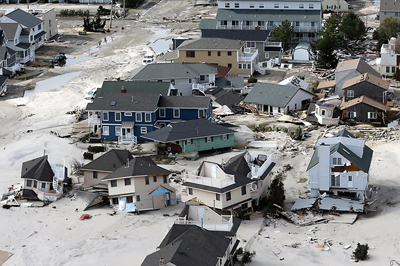BuildStrong Coalition Commends U.S. Senator Bob Menendez for Introducing Senate Version of The
Safe Building Code Incentive Act
The bill, which is co-sponsored by Senators Charles Schumer (D-NY) and Frank Lautenberg (D-NJ) and endorsed by fire chiefs, rewards states for adopting and enforcing strong building codes, ensuring additional disaster assistance to New Jersey and New York as they rebuild in the aftermath of Superstorm Sandy.
 The BuildStrong Coalition commended U.S. Senator Robert Menendez (D-NJ) of New Jersey for his leadership in introducing The Safe Building Code Incentive Act in the U.S. Senate. The Menendez bill, which is co-sponsored by Senators Charles Schumer (D-NY) and Frank Lautenberg (D-NJ) mirrors the bipartisan, H.R. 2069 in the House, would provide states that enforce statewide model building codes with an additional four percent of post-disaster relief assistance. The proposal applies valuable lessons learned from natural disasters by making homes and business built today stronger than those lost to Sandy. Building codes are the simplest and most effective means of mitigating against disasters, as they save lives, reduce damage, and reduce the need for future federal aid. The BuildStrong Coalition commended U.S. Senator Robert Menendez (D-NJ) of New Jersey for his leadership in introducing The Safe Building Code Incentive Act in the U.S. Senate. The Menendez bill, which is co-sponsored by Senators Charles Schumer (D-NY) and Frank Lautenberg (D-NJ) mirrors the bipartisan, H.R. 2069 in the House, would provide states that enforce statewide model building codes with an additional four percent of post-disaster relief assistance. The proposal applies valuable lessons learned from natural disasters by making homes and business built today stronger than those lost to Sandy. Building codes are the simplest and most effective means of mitigating against disasters, as they save lives, reduce damage, and reduce the need for future federal aid.
The Safe Building Code Incentive Act has been co-sponsored in the House by a bipartisan group of 40 lawmakers, which include 22 Democrats and 18 Republicans. It has garnered the support of several members of Congress from New Jersey and New York. Several of the nation’s leading fire services organizations have also endorsed the legislation, including The National Fire Protection Association, Congressional Fire Services Institute, International Association of Fire Chiefs, National Volunteer Fire Council and Fireman's Association of the State of New York.
"Senator Menendez is providing strong leadership at a time when it is crucial for lawmakers to provide assistance to help states recover from Sandy, while also providing the incentives to ensure that new buildings are constructed in a manner that will mitigate the damages and costs of future natural disasters," said Jimi Grande, chairman of the BuildStrong Coalition. "The fact that his bill has been co-sponsored by Senators Schumer and Lautenberg speaks volumes about the important role this bill can play in making communities more resilient to the impact of natural disasters. Strong building codes protect property, save lives and ultimately reduce taxpayer exposure to natural disasters. The BuildStrong Coalition is hopeful that the Safe Building Code Incentive Act will be attached to the Sandy relief bill."
The latest official estimates indicate that the damages associated with Sandy exceed $80 billion. In New Jersey alone, more than 70,000 buildings were seriously damaged. The BuildStrong Coalition has been promoting the Safe Building Code Incentive Act as a way to reduce the exorbitant costs associated with hurricanes, tornadoes, earthquakes and other natural disasters and to make our communities safer. Under the proposed law, 16 states that currently enforce model building codes would be eligible for additional assistance. New Jersey and New York are two states that have long enforced model building codes. By applying the provisions of the Safe Building Code Act retroactively to a date prior to Sandy, as the Menendez bill does, both states would receive extra rebuilding assistance from the federal government. |


 The BuildStrong Coalition commended U.S. Senator Robert Menendez (D-NJ) of New Jersey for his leadership in introducing The Safe Building Code Incentive Act in the U.S. Senate. The Menendez bill, which is co-sponsored by Senators Charles Schumer (D-NY) and Frank Lautenberg (D-NJ) mirrors the bipartisan, H.R. 2069 in the House, would provide states that enforce statewide model building codes with an additional four percent of post-disaster relief assistance. The proposal applies valuable lessons learned from natural disasters by making homes and business built today stronger than those lost to Sandy. Building codes are the simplest and most effective means of mitigating against disasters, as they save lives, reduce damage, and reduce the need for future federal aid.
The BuildStrong Coalition commended U.S. Senator Robert Menendez (D-NJ) of New Jersey for his leadership in introducing The Safe Building Code Incentive Act in the U.S. Senate. The Menendez bill, which is co-sponsored by Senators Charles Schumer (D-NY) and Frank Lautenberg (D-NJ) mirrors the bipartisan, H.R. 2069 in the House, would provide states that enforce statewide model building codes with an additional four percent of post-disaster relief assistance. The proposal applies valuable lessons learned from natural disasters by making homes and business built today stronger than those lost to Sandy. Building codes are the simplest and most effective means of mitigating against disasters, as they save lives, reduce damage, and reduce the need for future federal aid.


